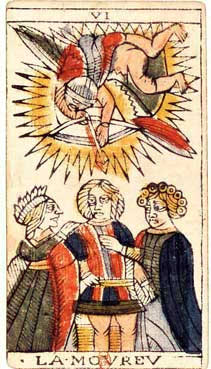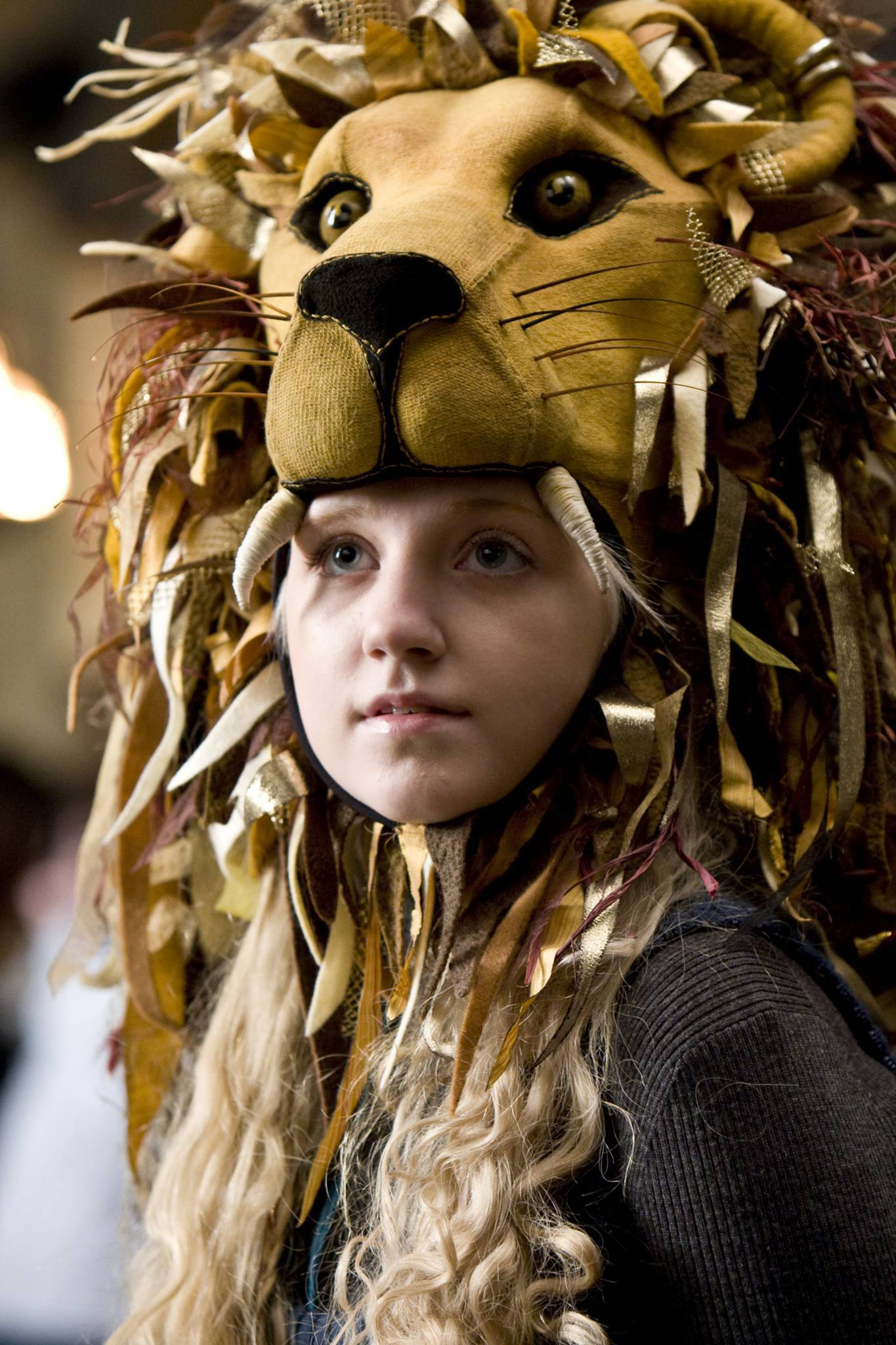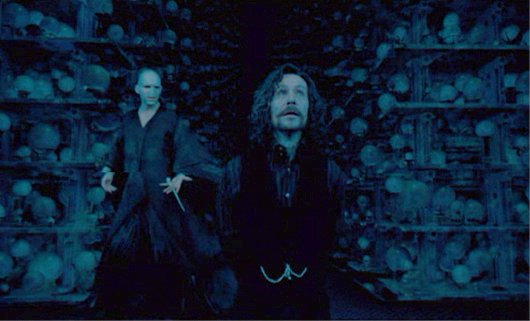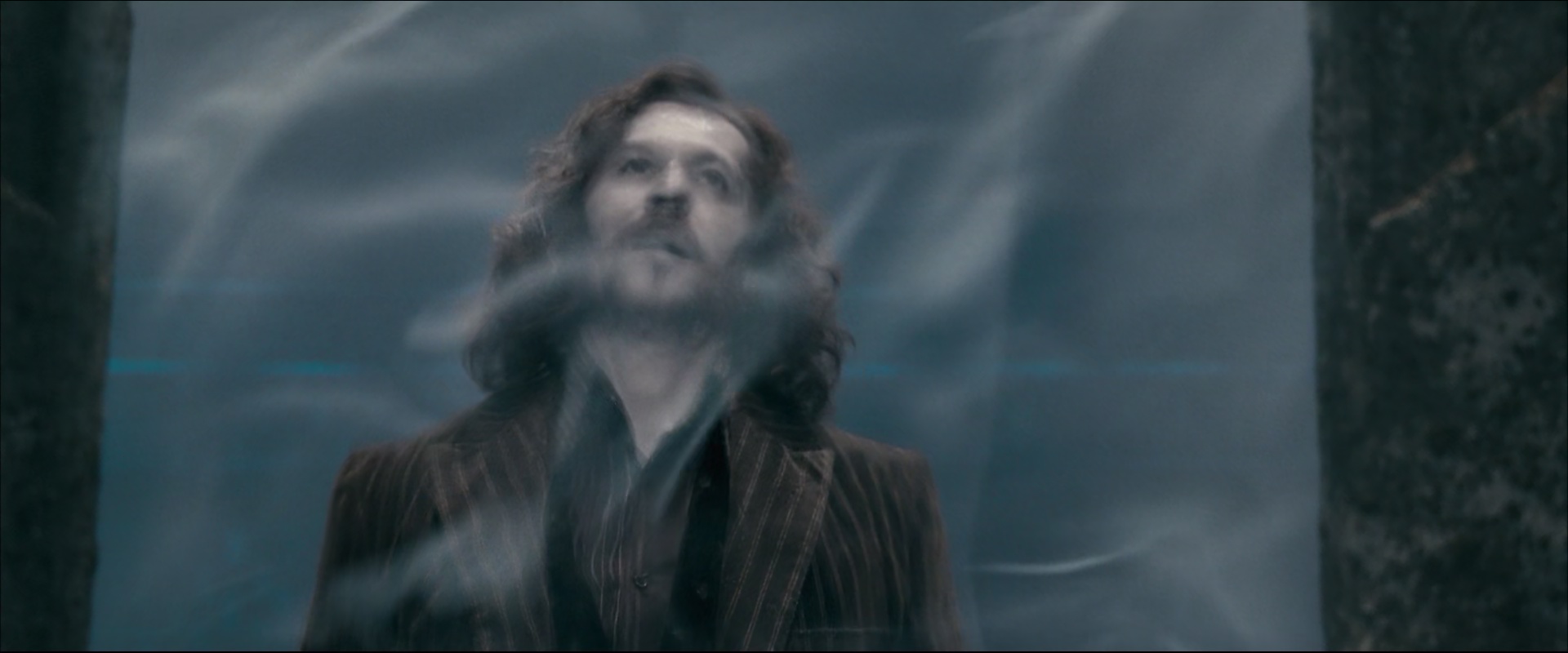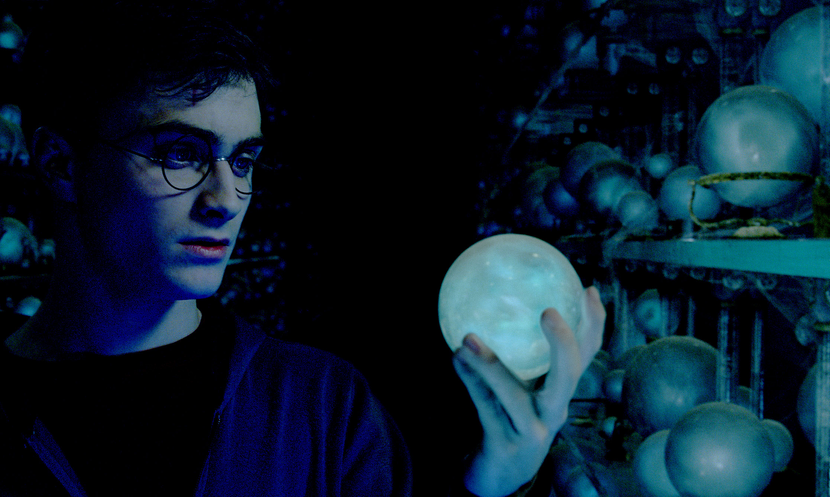Velvet soft the wizard trod
To the Sabbath of his God. . . .
Earlier yet his soul had come
To the Hill of Martyrdom . . . [King's Cross]
He had plucked the hazel rod
From the rude and goatish god . . . [Rubeus Hagrid]
[Philosopher's Stone.]
He had crucified a toad [Tom Riddle's diary]
In the basilisk abode, [the Chamber of Secrets]
Muttering the Runes averse [Parseltongue]
Mad with many a mocking curse.
[Chamber of Secrets.]
He had traced the serpent sigil [the Dark Mark]
In his ghastly virgin vigil
Sursum cor! the elfin hill, [the House Elves]
Where the wind blows deadly chill
From the world that waits beneath
Death's black throat and lipless teeth. . . . [the Dementors]
Surely in the circle millions
Of immaculate pavilions
Flash upon the trembling turf
Like the sea-stars in the surf—
Millions of bejewelled tents [wizard tents for the Quidditch World Cup]
For the warrior sacraments. [the Goblet of Fire]
[Azkaban and Goblet of Fire.]
THE ORDER OF THE PHOENIX
or,
THE LORD OF THE GATES OF MATTER
The Order of the Phoenix represents the darkest stage of the Work, where Harry must encounter the Abyss. Various Nigredo themes are apparent--overflowing toilets, black sludge, etc. Though he is not yet a full member of the Order of the Silver Star, having only passed as far as the Rose Cross, he is now classed as an Adept and taken under the protection of the Third Order --which J.K. Rowling calls the Order of the Phoenix. This is the Argentium Astrum, the (real) Illuminati. (Dumbledore founded the Order of the Phoenix; ergo, God is a member of the Illuminati.)
The next sphere reached by the aspirant is named Beauty, numbered 6, and referred to the heart, to the Sun, and to Gold. Here he is called an "Adept". . . . In the last sphere he learnt that his Body was the Temple of the Rosy Cross, that is, that it was given him as a place wherein to perform the Magical Work of uniting the oppositions in his Nature. Here he is taught that his Heart is the Centre of Light. It is not dark, mysterious, hollow, obscure even to himself, but his soul is to dwell there, radiating Light on the six spheres which surround it; these represent the various powers of his mind. . . . To this sphere hath the aspirant come by the Path called Temperance, shot as an arrow from a Rainbow. He hath beheld the Light, but only in division. (Aleister Crowley
 |
| (The Grail is dark.) |
The purpose of Harry Potter is to describe to the world the alchemical process that converts a mortal, flawed human being into an eternal, perfect Child of the Source of all life. This process consists of a gradual dissolution of the mortal human, and the reconstruction of the imperishable human being to replace him. The old microcosm with its old physical body is called "12 Grimmauld Place" in Harry Potter. This is an extremely apt name, for the old, fallen microcosm is a grim old place compared to the refulgent and glorious star like angelic being who lives in God's Eternal Universe. The number 12 refers to 12 magnetic focal points in the perimeter of the microcosm, which determine the quality of the forces operating within the human being. They determine all his desires and talents; they are his spiritual treasury.
The grim old place is the home of the ancient and noble house of Black: ancient because the microcosm is many millions of years old, noble because it was originally created by the Divine Spirit, but black because it has fallen out of the Kingdom of Heaven into an infernal universe full of death, suffering and anguish. (Harry Potter for Seekers)
The work on the Tomb of the Self is the subject of the book, wherein Harry must clean out the long-neglected house of Osirius Black, just as Christ must clean the Temple. ("But he spake of the temple of his body," John 2:21.)
 |
| Caput Mortuum |
One of the weirder images of Order of the Phoenix is the heads of dead house elves lining the stairway at the House of Black (“house,” by the way, is alchemical language for alembic or vessel). . . . “head of the dead” is also a symbol for “the initial stage of the opus, the black nigredo.”21 How appropriate for wall hangings in the House of Black! (John Granger, Harry Potter & the Alchemical Tradition in English Literature)
Within the house is a portrait of Mrs. Black (the chthonic, heartless Mother) that constantly screams against "MUDBLOODS" and "CREATURES OF DIRT," which shall profitably be compared with this passage from Manly P. Hall.
Man, the banished Adam, seeks to pass from the outer court of the Sanctuary (the exterior universe) into the sanctum sanctorum, but before him rises a vast creature armed with a flashing sword that, moving slowly but continually, sweeps clear a wide circle, and through this "Ring Pass Not" the Adamic man cannot break.
The cherubim address the seeker thus: "Man, thou art dust and to dust thou shalt return. Thou wert fashioned by the Builder of Forms; thou belongest to the sphere of form, and the breath that was breathed into thy soul was the breath of form and like a flame it shall flicker out. More than thou art thou canst not be. Thou art a denizen of the outer world and it is forbidden thee to enter this inner place."
The cherubim address the seeker thus: "Man, thou art dust and to dust thou shalt return. Thou wert fashioned by the Builder of Forms; thou belongest to the sphere of form, and the breath that was breathed into thy soul was the breath of form and like a flame it shall flicker out. More than thou art thou canst not be. Thou art a denizen of the outer world and it is forbidden thee to enter this inner place."
Genetics is big in the Potterverse. And it would be, since alchemy is about transcending one's genes (read: Djinns). Hermione is a mudblood (that is, a mortal creature of dust, like Mary), but she learns well; i.e. is receptive to Ron's Sulphur. Hermione forms SPEW (Albedo resonance) to free the House Elves from servitude; i.e. the elementary spirits within the human body.
Harry communes with Sirius through the fire. (Another "boy who lived.")
The Sorting Hat calls for the four Hogwarts houses (elements) to join together to confront Voldemort. The houses are representative of Eliphas Levi's Four Powers of the Sphinx, "To Know, to Dare, to Will, and to Keep Silence." Evidently Rowling's attribution is:
Harry communes with Sirius through the fire. (Another "boy who lived.")
 |
| Motto: "Never wake a sleeping dragon" (don't mess with Major Tom) |
The Sorting Hat calls for the four Hogwarts houses (elements) to join together to confront Voldemort. The houses are representative of Eliphas Levi's Four Powers of the Sphinx, "To Know, to Dare, to Will, and to Keep Silence." Evidently Rowling's attribution is:
Gryffindor: Leo Lion Fire Will
Slytherin: Scorpio Dragon Water Dare
Ravenclaw: Aquarius Man Air Know
Hufflepuff: Taurus Bull Earth Keep Silence
Now, as Lily (spirit) is dead, Harry Potter the Demiurge has to re-create her by impregnating matter. Lily, as a type of the Lamb Slain from the Foundation of the World, sacrified herself for Harry; this sacrificed Goddess is the true and hidden Christ whose blood, as the lumen naturae, courses through Harry's veins.
Harry's task in the volume is to encounter the Abyss, represented by the path of the High Priestess on the Tree of Life. Empress vs. High Priestess vs. Justice vs. Strength represent some of the dynamics at play as Harry unveils the Mysteries of Nature. "She is, in fine, the Queen of the borrowed light, but this is the light of all" (Waite).
Harry's task in the volume is to encounter the Abyss, represented by the path of the High Priestess on the Tree of Life. Empress vs. High Priestess vs. Justice vs. Strength represent some of the dynamics at play as Harry unveils the Mysteries of Nature. "She is, in fine, the Queen of the borrowed light, but this is the light of all" (Waite).
Nymphadora Tonks is Adjustment, the Harlequin, who performs for Harry the Fool. "'Tonk' literally means, 'a fool or idiot'." The simplest explanation for her first name is that she is a "nympho," which correlates with her designation as the "Woman Satisfied." "It is a mystery of the soul's love, and for this reason she is called 'undaunted daughter of desire'" (Waite). Nature is dark and desires to be filled with Fire. "Without your fire's might, I have not been able to be happy, for you are my husband; by you my own brightness is revealed" (Boehme). This is Mission: Impossible.
Tonks' hair is described as pink, a color otherwise associated with Dolores Umbridge. This is the negative side of Justice. Umbridge, as the high inquisitor of MOM (the Ministry of Magic), wants every jot and tittle of the karmic Law accounted for. As she holds the test-icular scales of justice in her hands, it will be unsurprising that Harry will be subjected to the rigors of the Ordinary Wizarding Level (OWL) examinations.
[A]lchemy explains the structure and bizarre events of . . . Harry Potter and the Order of the Phoenix. From its hot and dry beginnings in Harry’s sojourn in the House of Black to his time at Hogwarts under the police state of Dolores Umbridge (a fascinating cryptonym, which may mean “grieving resentment,” “grievous shadow,” or “a woman who blocks the sun”) to the death of his godfather at the end, Order of the Phoenix is the nigredo volume of the series. (Granger)
Make no mistake, Dolores Umbridge is the Devil. And she is a Devil that no-one would ever have any sympathy for. For the Devil of the Tarot's great mockery is to insist that matter is all there is, and nothing else: Umbridge steadfastly and continually denies that Voldemort has returned, in the face of overwhelming evidence to the contrary. (In the book she is distinctly described as a "toad," representing the aspects of the Work that resist transformation.)
The Devil's uplifted right hand has all its fingers open ... "What sensation reports is all there is to know." On the palm of this uplifted hand is outlined an astrological symbol of the planet Saturn, ruling in Capricorn. Saturn is the planet of limitation, inertia, and therefore of ignorance. In his left hand is a torch, bruning wastefully, and giving little light. (Paul Foster Case, Tarot, 1949, p.158)
Dolores Umbridge constantly reminds everyone of their sins, real and imagined; she wants naughty children to be punished. Harry receives his stigmata doing lines for her. But the Law is flawed; the notorious Rita Skeeter, as karmic recorder, publishes nothing but lies and half-truths in the newspapers.
Harry will need every resource to baffle his accusers.
J.K. Rowling's solution to the barren and implacable Mater Dolorosa Umbridge is to drag her into the forest (by Hermione Granger, no less) and have her raped by centaurs (srsly). This is another key.
The Devil's uplifted right hand has all its fingers open ... "What sensation reports is all there is to know." On the palm of this uplifted hand is outlined an astrological symbol of the planet Saturn, ruling in Capricorn. Saturn is the planet of limitation, inertia, and therefore of ignorance. In his left hand is a torch, bruning wastefully, and giving little light. (Paul Foster Case, Tarot, 1949, p.158)
Similarly, the head of the Ministry of Magic, Cornelius Fudge (the dark, ignorant self, lost in the mire of shit) is Neville Chamberlain--he thinks Voldemort can be ignored. But fascism arises from within the MOM itself, and not from an external source. (Homeland Security.)
Several comparisons have been made between Fudge and real-life British Prime Minister Neville Chamberlain, who bowed to Adolf Hitler's territorial demands at the Munich Conference and foolishly announced "peace in our time" in 1938, shortly before the outbreak of World War II.'
So HP is intentionally a WWII allegory--or rather, Rowling seems to know that WWII is an allegory for something else altogether.
Dolores Umbridge constantly reminds everyone of their sins, real and imagined; she wants naughty children to be punished. Harry receives his stigmata doing lines for her. But the Law is flawed; the notorious Rita Skeeter, as karmic recorder, publishes nothing but lies and half-truths in the newspapers.
Harry will need every resource to baffle his accusers.
J.K. Rowling's solution to the barren and implacable Mater Dolorosa Umbridge is to drag her into the forest (by Hermione Granger, no less) and have her raped by centaurs (srsly). This is another key.
Harry tries to date Cho Chang (Asians = Assiah, the realm of corporeal 3D), but all she can do is cry over the loss of Cedric Diggory. The Mater Dolorosa is again implied. Cho appears in a dream to Harry and asks for his Firebolt broom; i.e. the barren Woman wishes to be impregnated with his phallic energy.
His new friend Luna is another alchemical symbol. “Luna is the bride, the white queen, consort of King Sol. She is the moist, cold, receptive principle which must be united with Sol, the dry, hot, active principle in the chemical wedding.” . . . (Granger)
Luna Lovegood's spirit of hope, acceptance and blind faith will pull him through, as she knows that all of her possessions (fragments of Self, foreshadowing Voldemort's Horcruxes), though presently lost, will come together in the end. Luna and Harry, having seen Death (the Nigredo), now have the ability to see Thestrals ("astrals").
In chapter 19, "The Lion and the Serpent," Luna wears her lion headdress, showing her identification with the "Strength" card of the Tarot. Ron Weasley, as the Quidditch "Keeper," effectively plays for both Slytherin (the Serpent) and Gryffindor (the Lion) as phallic Sulphur; he must prove his allegiance to Gryffindor.
It is the science of fire; everywhere we find the enchanter who pierces the lion and leads the serpents—the lion is the celestial fire, and the serpents are the electrical and magnetic currents of the earth. It is to this great secret of the Magi that we must refer all the marvels of Hermetic Magic, whose traditions still declare that the arcanum of the magnum opus consists in the government of fire. (Eliphas Levi)
Rowling's debt to Eliphas Levi is seen in her making Elphias Doge a member of the Order of the Phoenix, and one of Dumbledore's oldest and closest friends.
In chapter 19, "The Lion and the Serpent," Luna wears her lion headdress, showing her identification with the "Strength" card of the Tarot. Ron Weasley, as the Quidditch "Keeper," effectively plays for both Slytherin (the Serpent) and Gryffindor (the Lion) as phallic Sulphur; he must prove his allegiance to Gryffindor.
It is the science of fire; everywhere we find the enchanter who pierces the lion and leads the serpents—the lion is the celestial fire, and the serpents are the electrical and magnetic currents of the earth. It is to this great secret of the Magi that we must refer all the marvels of Hermetic Magic, whose traditions still declare that the arcanum of the magnum opus consists in the government of fire. (Eliphas Levi)
Rowling's debt to Eliphas Levi is seen in her making Elphias Doge a member of the Order of the Phoenix, and one of Dumbledore's oldest and closest friends.
Ron Weasley, as Red Sulphur, is the "King". He and Hermione are Prefects and Harry has a vision of them "crowned," i.e. their true worth as the King and Queen that must be wed is at last revealed to him. They will excel the Demiurge.
And if Dolores Umbridge is the Devil as Matter, then Lord Voldemort is a more traditional figure of the Devil as Choronzon, the Lord of Hallucinations. To cut a very, very long story short, Harry, having now fully integrated his Shadow, is subjected to the full force of madness and dispersion that comes with his encounter with the Second Veil of the Abyss.
In the Qabalistic system of Crowley, the Abyss contains the 11th (hidden) sephira, Da'ath, which separates the lower sephiroth from the supernals. . . . The Abyss is guarded by the demon Choronzon . . . He represents those parts of one's consciousness and unconsciousness -- "a momentary unity capable of sensation and of expression," in Crowley's terms -- that are unwilling or unable to enter the Divine.
At first glance, it would seem that Harry is farther along than he really is, but he has only been circling the drain of the Abyss. This is why Harry spends so much time in the Room of Requirement (the room-that-is-not-a-room) in the fifth book, symbolic of Da'ath (the sephira-that-is-not-a-sephira). Just as Da'ath harbors all possibilities, the Room of Requirement alters itself to the needs of the aspirant. This room "doesn't show up on the [Marauder's] map," a magical item that shows him all of the rooms in Hogwarts, and is symbolic of the Kabbalistic Tree of Life. Harry, as a type of Moses, raises up Dumbledore's Army (the Israelites as fragments of Self) in this wilderness. To aid this mission, Hermione devises enchanted Galleons, symbolic of Pentacles, or Matter impregnated by Spirit (a consistent theme of this volume).
 |
| See? Da'ath ain't there. |
This entity also is known as the spirit of dissolution and Lord of Hallucinations. Everyone who comes in contact with Choronzon falls into ruin. The demon is said to create confusion of thought and turn people insane. (James Donahue)
 |
| Room 237 |
Once Upon A Time
There Were Two Little Girls
Who Lived In A House
Voldemort subjects the aspirant to the full force of his insanity. It is constantly emphasized that Voldemort exists within Harry; they have become one mind, divided against itself. Harry becomes obsessed with the fact that he's a bad person. Harry is subjected to a (true) vision of "Arthur" Weasley's bleeding wound from the serpent--the wound of the Grail King. (This has been discussed previously.)
In part 5 of Harry Potter there are even more similarities [to the Chemical Wedding of Christian Rosenkreuz] . . . For example both Harry and CRC struggle with a dream of a door they can’t open, and in both stories a dream is mentioned in which scissors play a role. Harry dreams of his two friends, Hermione and Ronald, wearing crowns. CRC sees the young king and queen, who are later reborn after the alchemical process, with a crown hanging over their heads. But the most remarkable co-incidence of all is a secret room. In both stories there is a room that is always locked. In The Alchemical Wedding CRC is told that this is the sepulchre of (sleeping) Venus. In part 5 of Harry Potter we are told that There is a room[...]that[...]contains a force that is at once more wonderful and more terrible than death, than human intelligence, than the forces of nature.[...] It is the power held within that room that you possess in such quantities and which Voldemort has not at all. 1 This force is love, which is called Venus in The Alchemical Wedding. (HPFS)
More hallucinations follow. Voldemort-Choronzon subjects Harry to another, altogether false vision of Sirius Black being tortured in the Department of Mysteries, the name of which should be ample proof that what takes place there should not be interpreted literally. Thus it is thematically appropriate that he descends into the Ministry of Magic, or the chthonic MOM, in order to rescue Sirius (Self).
The Second Veil of the Abyss is found here, in the most literal way possible.
Under the second triad, formed by Chesed, Geburah and Tiphereth, is another barrier, called the Veil. The Veil shields our ordinary consciousness (below the Veil where the next four Sephirah are) from the deeper contents of our soul, above the Veil). The Veil is the same as the veil in the temple, the curtain that shields the mysteries from the profane. Only the initiated can pass the veil. It is also the veil or curtain behind the High Priestess in the Tarot. (Qabala Info)
 |
| The Dweller on the Threshold; or, FUCK YEAH WIZARD BATTLES |
"Master was a nasty ungrateful swine who broke his mother's heart--"
"My mother didn't have a heart, Kreacher," snapped Sirius. "She stayed alive out of pure spite."
"My mother didn't have a heart, Kreacher," snapped Sirius. "She stayed alive out of pure spite."
Kreacher ("Creature") the House-Elf revolted against his master, leading to Sirius' death; i.e., the elementary spirits within the human body revolt against the alchemist's attempts to bring ordo ab chao. But this, like HAL's rebellion, was due to their mistreatment and neglect.
- AE-35 unit: not broken, HAL fakes it, but Frank Poole dies anyways (once he goes to investigate). Dave now knows that he must kill HAL.
- Department of Mysteries: Sirius Black isn't there, Voldemort and Kreacher both fake it, but Sirius dies anyways (once he goes to investigate). Harry now knows that he must kill Voldemort.
Harry is burnt up, broken down or dissolved, and bled until everything that he thought he was—star Quidditch player, his best friend’s superior, pet of the headmaster, lover of his school, son and spitting image of a great man, victim of the Dursleys, valiant enemy of Snape, even his being the hero and man of action in time of crisis—is taken from him or revealed as falsehood. The boundaries of his world collapse . . . The world is no longer separated into good guys and bad guys. Harry has been reduced to his formless elements. . . . Harry has been undone by his experiences: He knows his parents aren’t gods; he can’t play quidditch; his lack of self-awareness and his resentment and self-pity cause his godfather’s death; he can’t act at will; he can’t get information; his mentor Dumbledore is strangely absent; the world hates him; he suffers privately for the truth (“I will not tell lies”); and his friends are honored before him. This dissolution, though, is not his purification, and so we are left at book’s end with only the formless dregs of Harry’s character, which, frankly, are not pretty.
There are other alchemical symbols in Order of the Phoenix as well—the black king, for example. Kingsley Shacklebolt is not a token black character but an alchemical reference to the “black king.” The king of the alchemical work must die, usually by drowning, and “at this stage the matter is at its blackest black and is known as the black king.” (Granger)
In the depths of the Department of Mysteries, Harry at last learns of the Prophecy that will define his life from this point forward. (That is, he discovers who he really is.) Like Aeneas when he plucked the Golden Bough, it is the character named Sibyll who tells him his destiny: Harry's task is far from over, and he must kill or be killed by Voldemort. Again, he shouldn't have messed with the Tom Riddle, and now he's a marked man. The Shadow must be immolated. (The moral here is, don't listen to a word I say.)
With Harry, we are reduced to our fundamental decision in life: Do I live a life of love for the “new man” and for the Christ in me, or do I appease the “old man ” and live with death until my biological death seals my choice? . . . Order of the Phoenix is a book-length disillusionment for Harry to rid himself of his self-illusions and to prepare him for the revelation of who he really is at bottom: the destined vanquisher or victim of the Dark Lord, as are we all. . . . Harry's struggle to embrace his prophesied destiny as the Dark Lord's vanquisher through love and light is the human struggle to do the same with the darkness in our fallen, hardened hearts. (Granger, Looking for God in Harry Potter, 163-7)













